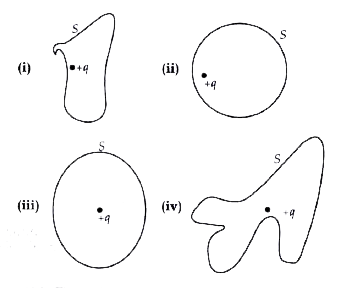The total electric flux leaving a spherical surface of radius 1 cm and surrounding an electric dipole is
qε0
zero
2qε0
infinite
The correct Answer is:B
To solve the problem of finding the total electric flux leaving a spherical surface of radius 1 cm that surrounds an electric dipole, we can follow these steps:
1. Understand the Electric Dipole: An electric dipole consists of two equal and opposite charges, +q and -q, separated by a distance. The dipole moment (p) is defined as p=q⋅d, where d is the distance between the charges.
2. Identify the Gaussian Surface: We consider a spherical Gaussian surface of radius 1 cm surrounding the dipole. According to Gauss's Law, the electric flux (Φ) through a closed surface is given by:
Φ=Qinsideϵ0
where Qinside is the total charge enclosed by the surface and ϵ0 is the permittivity of free space.
3. Calculate the Total Charge Inside the Gaussian Surface: For an electric dipole, the total charge is:
Qinside=+q+(−q)=0
Since the dipole consists of equal and opposite charges, the net charge enclosed by the Gaussian surface is zero.
4. Apply Gauss's Law: Substituting Qinside=0 into Gauss's Law gives:
Φ=0ϵ0=0
5. Conclusion: The total electric flux leaving the spherical surface surrounding the electric dipole is zero.
Final Answer:
The total electric flux leaving the spherical surface surrounding the electric dipole is 0.
---
Φ=Qinsideϵ0
where Qinside is the total charge enclosed by the surface and ϵ0 is the permittivity of free space.
Qinside=+q+(−q)=0
Since the dipole consists of equal and opposite charges, the net charge enclosed by the Gaussian surface is zero.
Φ=0ϵ0=0
The total electric flux leaving the spherical surface surrounding the electric dipole is 0.
Topper's Solved these Questions
- ELECTRIC CHARGES AND FIELDSBook:NARAYNAChapter:ELECTRIC CHARGES AND FIELDSExercise:EXERCISE -1 (H.W)
Explore 27 Videos
- ELECTRIC CHARGES AND FIELDSBook:NARAYNAChapter:ELECTRIC CHARGES AND FIELDSExercise:EXERCISE -2 (C.W.)
Explore 39 Videos
- ELECTRIC CHARGES AND FIELDSBook:NARAYNAChapter:ELECTRIC CHARGES AND FIELDSExercise:C.U.Q
Explore 81 Videos
- DUAL NATUREBook:NARAYNAChapter:DUAL NATUREExercise:LEVEL-II (H.W)
Explore 17 Videos
- ELECTRO MAGNETIC INDUCTIONBook:NARAYNAChapter:ELECTRO MAGNETIC INDUCTIONExercise:Level-II (H.W)
Explore 23 Videos
Similar Questions
Electric charges are distributed in a small volume.The flux of the electric field through a spherical surface of radius 1m surrounding the total charge is 100V−m.The flux over the concentric sphere of radius 2m will be:
View SolutionElectric charge are distributed in a small vouume. The flux of the electric field through a spherical surface of rasius 10cm surrounding the total charge is 25 V m. The flux over a concentric sphere of radius 20 cm will be
View Solution
Knowledge Check
Electric charges are distributed in a small volume. The flux of the electric field through a spherical surface of radius 20 cm surrounding the total charge is 50 V-m. The flux over a concentric sphere of radius 40 cm will be :
A50 V-mB75 V-mC100 V-mD200 V-mThe electric charges are distributed in a small volume. The flux of the electric field through a spherica surface of radius 10 cm surrounding the total charge is 20V−m. The flux over a concentric sphere of radius 20 cm will be
A20 VmB10 VmC40 VmD5 VmThe electric flux through a hemispherical surface of radius R placed in a uniform electric field E parallel to the axis of the circular plane is
A(2πR)EB(πR2)EC(43πR3)ED(23πR3)E
The electric flux through the surface :

View SolutionElectric Flux And Equipotential Surface
View SolutionA region surrounding a stationary electric dipoles has
View SolutionThe electric charges are distributed in a small volume. The flux of the electric field through a surface of radius 10 cm surrounding the total charge is 20 Vm. The flux over a concentric sphere of radius 20 cm will be
View SolutionGiven below are two statements :
Statement I : An electric dipole is placed at the centre of a hollow sphere. The flux of electric field through the sphere is zero but the electric field is not zero anywhere in the sphere.
Statement II : If R is the radius of a solid metallic sphere and Q be the total charge on it. The electric field at any point on the spherical surface of radius r(<R) is zero but the electric flux passing through this closed spherical surface of radius r is not zero.
In the light of the above statements, choose the correct answer from the options given below :
View Solution